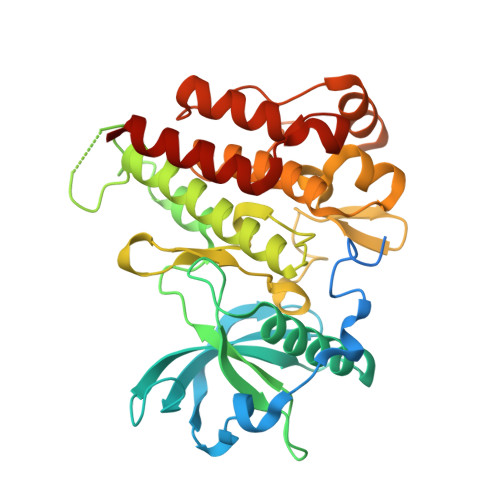Molecular Conformations, Interactions, and Properties Associated with Drug Efficiency and Clinical Performance Among Vegfr Tk Inhibitors.
McTigue, M., Murray, B.W., Chen, J.H., Deng, Y., Solowiej, J., Kania, R.S.(2012) Proc Natl Acad Sci U S A 109: 18281
- PubMed: 22988103
- DOI: https://doi.org/10.1073/pnas.1207759109
- Primary Citation of Related Structures:
4AG8, 4AGC, 4AGD, 4ASD, 4ASE - PubMed Abstract:
Analyses of compounds in clinical development have shown that ligand efficient-molecules with privileged physical properties and low dose are less likely to fail in the various stages of clinical testing, have fewer postapproval withdrawals, and are less likely to receive black box safety warnings. However, detailed side-by-side examination of molecular interactions and properties within single drug classes are lacking. As a class, VEGF receptor tyrosine kinase inhibitors (VEGFR TKIs) have changed the landscape of how cancer is treated, particularly in clear cell renal cell carcinoma, which is molecularly linked to the VEGF signaling axis. Despite the clear role of the molecular target, member molecules of this validated drug class exhibit distinct clinical efficacy and safety profiles in comparable renal cell carcinoma clinical studies. The first head-to-head randomized phase III comparative study between active VEGFR TKIs has confirmed significant differences in clinical performance [Rini BI, et al. (2011) Lancet 378:193-1939]. To elucidate how fundamental drug potency-efficiency is achieved and impacts differentiation within the VEGFR TKI class, we determined potencies, time dependence, selectivities, and X-ray structures of the drug-kinase complexes using a VEGFR2 TK construct inclusive of the important juxtamembrane domain. Collectively, the studies elucidate unique drug-kinase interactions that are dependent on distinct juxtamembrane domain conformations, resulting in significant potency and ligand efficiency differences. The identified structural trends are consistent with in vitro measurements, which translate well to clinical performance, underscoring a principle that may be broadly applicable to prospective drug design for optimal in vivo performance.
Organizational Affiliation:
Department of Oncology Medicinal Chemistry, Pfizer Worldwide Research and Development, Pfizer Inc., San Diego, CA 92121, USA.















